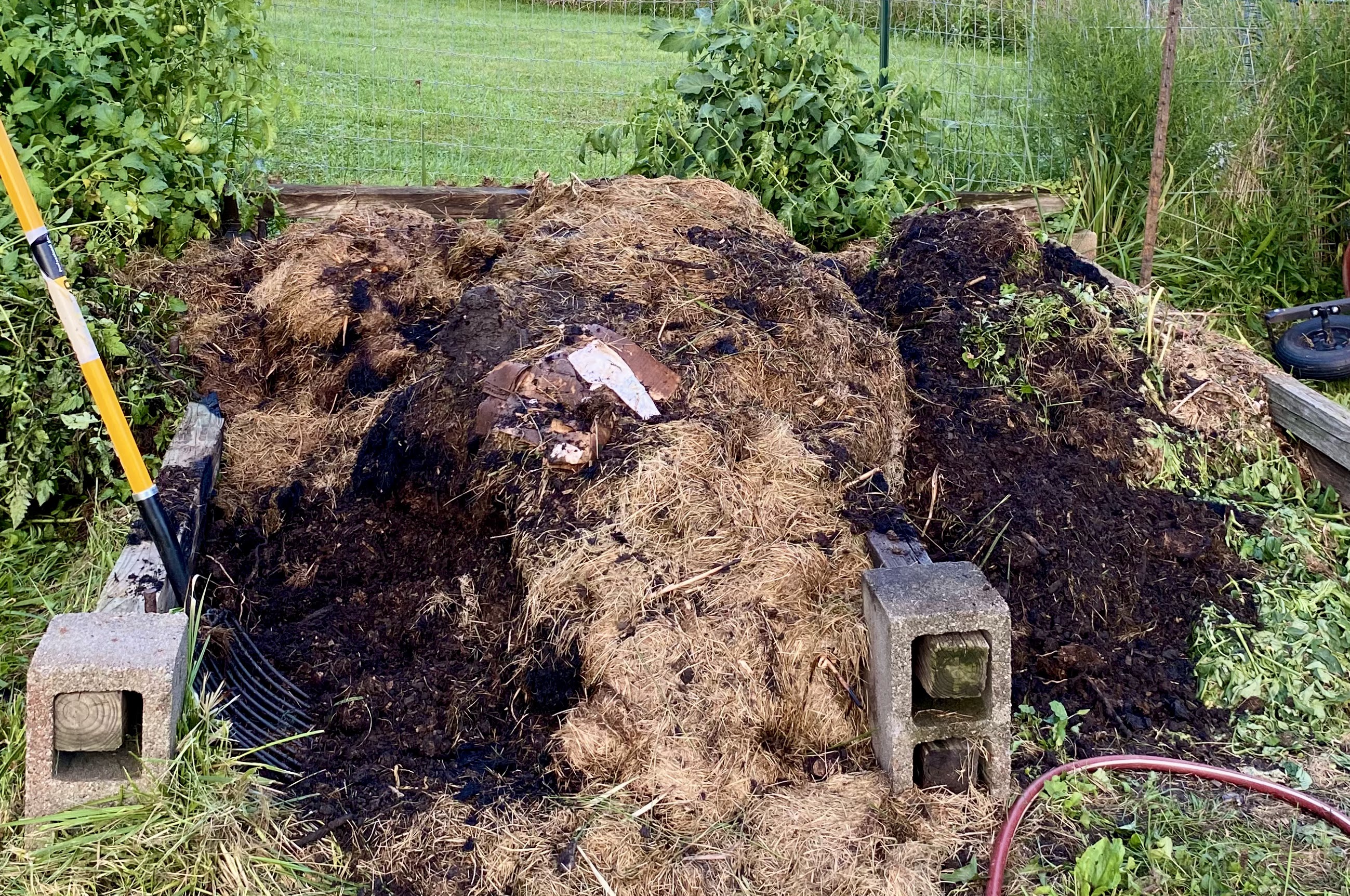Your cart is currently empty!
We’ve got… soil!
“There are two spiritual dangers in not owning a farm. One is the danger of supposing breakfast comes from the grocery, and the other is that heat comes from the furnace.”
– Aldo Leopold

A bit of a mishap led to a great discovery in our compost pile this week.
For the last year we’ve been composting in an area of about 80 square feet. A simple construction of concrete block and old landscaping timbers delineates two, ten by four foot beds in which we turn material. Despite frequent turning early on, the pile never seemed to take off. No evidence of a “hot” pile with aerobic bacteria (mesophiles) breaking down material like we wanted to see. After a really wet spring -the wettest May in Ohio’s recorded history – we ended with a lot of cut grass to throw onto the pile. We also fell behind on turning the pile. The heap of grass just sat there, browning and lifeless.

And then it caught fire.
Literal fire.


Likely the fire was sparked from a small fire I set to burn some of the downed branches and other brush that had accumulated over the course of the year. Bad fire discipline, I know. Regardless, the grass pile caught fire. It wasn’t a raging fire. Rather, a slow smolder burning its way through patches of dry material in between layers of wet grass and wood chips. Even after being doused generously with water before going to bed, the fire apparently smoldered on, eventually burning its way through a couple of the timbers framing the pile. Thankfully there isn’t really anywhere for the fire to spread. It smoked periodically throughout a second day, getting a decent soaking of water every time it seemed ready to flare up again.
It wasn’t until this small fire, however, that we got in there and really turned over all of the material. And there, beneath the smoldering wet grass remnants, was gorgeous, nicely broken down soil.

Yes, soil! Underneath that huge mound of discarded grass clippings decomposition was steadily breaking down an older mixture of grasses, broad leaf weeds, discarded vegetable matter, cardboard, wood chips, and manures from both our chickens and goats. From these cast-off remnants, our trash really, we received rich, nutrient dense, beautiful, fertile compost!
To say we’re excited is an understatement. For our small homestead being able to create our own soil is a huge sustainable leap forward. The cubic yard or so of material created through this process will go back into regenerating our land instead of ending up in a landfill or similarly being lost to us. Creating our own soil is huge!
The newly formed soil from our compost compliments another soil building initiative we’ve taken on at the homestead. In addition to composting lawn debris and other matter, we’re also creating nutrient rich vermicompost, or worm castings, through two worm farms we started this summer.


These worm farms employ a constantly expanding army of red wriggler worms to break down kitchen scraps, shredded paper, and other compostable materials. The feeding worms effectively break all of this material down into nutrient dense packages (how’s that for saying poop without saying poop?). This vermicompost can be used to further boost soil health. As an added bonus, excess moisture can be harvested directly from the containers for use as a compost tea.
Why the emphasis on soil building?
Because soil is literally life. All of us, all of mankind, depend on a thin layer of topsoil to sustain life on the planet. This thin layer, the uppermost soil horizon (hence the name topsoil… get it?) is teaming with life. How much life? There are more organisms in a single teaspoon of this topsoil than there are humans on earth. And this topsoil, with all of its organisms, is essential to grow 95% of the food we eat.
Yet despite soil’s importance, nearly half of the most productive soil has disappeared over the course of the last 150 years. Sadly, according to Stanford University, we lose about one percent of our topsoil every year now to erosion. Most of this is due to practices that strip the topsoil of its nutrients and life without adequate thought towards regenerating the soil. Currently we lose soil at a rate of 10 times our soil replenishment rate in the US. In some countries that rate is approaching losses at 50 times the replenishment rate.
So for us, soil is very important. On our homestead creating soil is just one more step towards a healthier and more sustainable future. We can create our own soil without relying on external sources. We can build land, both additional soil and increased nutrients. We can replace and even increase soil health while producing food for our family. We can save money and reduce waste at the same time in a way that continually rebuilds our land. And in return, our land provides so much for our homestead.

One response to “We’ve got… soil!”
[…] rejuvenation. We’ve demonstrated we can make soil here on our little 5-acre homestead (see: https://headwatershomestead.org/2022/08/23/weve-got-soil/). Imagine what we could accomplish by putting all our heads together in stopping the degradation […]